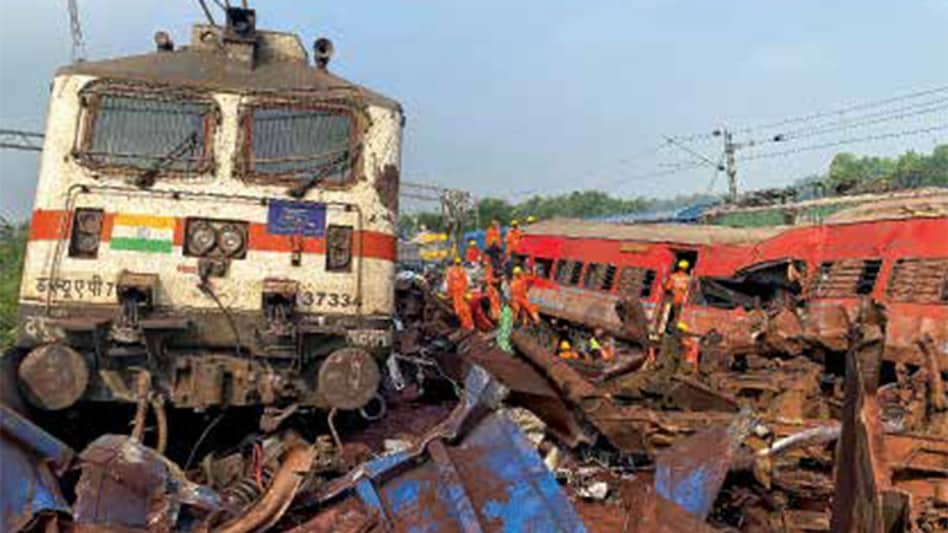 As the country’s economic backbone, the Indian Railways needs to implement not only ‘Make in India’ but also ‘Maintain in India’ to enhance safety
As the country’s economic backbone, the Indian Railways needs to implement not only ‘Make in India’ but also ‘Maintain in India’ to enhance safety  As the country’s economic backbone, the Indian Railways needs to implement not only ‘Make in India’ but also ‘Maintain in India’ to enhance safety
As the country’s economic backbone, the Indian Railways needs to implement not only ‘Make in India’ but also ‘Maintain in India’ to enhance safety A report by the Commissioner of Railway Safety (CRS) for the South Eastern Circle of the Indian Railways blames technical lapses in signalling for the triple train accident on June 2.
But experts say that the report fails to clearly identify the underlying causes to prevent a recurrence. The accident in Odisha’s Balasore district left 295 dead and over 1,200 injured. Incidentally, it bears an eerie similarity to the 1999 Gaisal train accident in West Bengal, where two passenger trains collided, killing around 300 passengers, again due to a signalling error. “There are specific issues that successive railway inquiries have failed to capture,” warns safety expert Lalit Chandra Trivedi, who retired as General Manager of East Central Railway.
A railway system has two components comprising fixed and rolling stock infrastructure. The fixed infrastructure—including stations, signalling, track and overhead electrical equipment (OHE)—requires regular maintenance. However, these need blocks or a brief curtailment of rail operations, which haven’t been given priority throughout the system, says Trivedi. He cites an instance to highlight how these blocks make a big difference to railway safety. In the mid-2000s, there was a spate of accidents on Mumbai’s suburban railway network. “We decided to allocate blocks from midnight to four in the morning. They were announced widely so that all agencies and contractors were aware and planned to complete the maintenance work within those four hours. Post its implementation, there has been a remarkable improvement in the safety of Mumbai’s suburban railway,” he says.
In the aftermath of the Gaisal crash too, it was decided to widely advertise such blocks. However, the railways failed to roll out a similar system on a pan-India basis. Consequently, departments like signalling, track and OHE often end up chasing the operations department for blocks. And it is this particular aspect that has been ignored in the CRS report. “Although incidents of derailment have gone down in the railways due to infrastructure addition, collisions and fires have gone up,” says Trivedi. “The first priority should be repair and maintenance. The second priority should be running the trains. The third priority should be upgrading the technology,” says the head of a global railway OEM requesting anonymity.
The other recommendation is on homogenisation of safety processes across the world’s fourth-largest rail network. With 19 railway zones—including the Kolkata Metro—simultaneously
maintaining safety and operations is a complex task. Over the years, the railways has imbibed new technologies such as the point machine, relay, interlocking, audio frequency track circuit (AFTC) and multi-section digital axle counter (MSDAC). “While the railways has moved well in adopting different technologies, these are available in multiple layers and, therefore, harmonising them is critical,” says the OEM head.
The Balasore accident has put the spotlight back on the adoption of new and cutting-edge technologies to overhaul safety. Excluding the signalling part, which is now electronic, a large number of inspections continue to happen manually. For instance, a trip inspection of a train before clearing it for a long-distance journey may involve manually inspecting up to 5,000 parts. But new technologies can help in making this exercise hassle-free. “In a trip inspection, you can use multiple cameras on a stationary locomotive to do its 360-degree scan before deployment. It is now possible to put multiple cameras on a moving trolley to actually capture any anomaly on the track. For OHE, it is possible to mount machine vision cameras on a tower wagon to check if everything is fine,” says Bharat Salhotra, Co-founder & President of deep tech firm Insightzz. “Deployment of AI-based solutions can help in improving safety as well as the asset’s uptime.”
But that won’t happen unless an enabling ecosystem taking care of not just making products in India but also maintaining them locally gets created. “It’s a huge opportunity. We find so many engineers working in fintech or AI/ML across different sectors. But then how many of them are actually working in the railway sector? Let’s get some of them to work on developing solutions for the Indian Railways,” says the OEM head.
With the railways’ targets for passengers and freight carriage going up with each passing year, the two aspects of safety and higher passenger and freight loads often work at cross-purposes. It will, therefore, be imperative to support the resulting increase in capacity with innovative technologies.
@manishpant22
Copyright©2023 Living Media India Limited. For reprint rights: Syndications Today